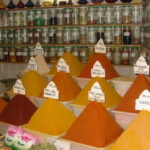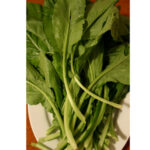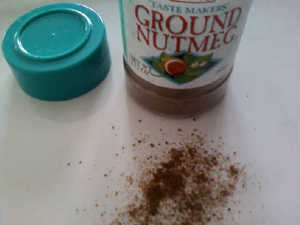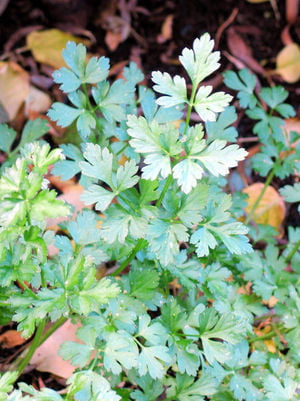In the U.S. Alone, some 200 million pounds of herbs and spices are consumed annually, with black pepper, cinnamon, nutmeg, garlic, paprika, chili powder, oregano, celery (seeds and salt), onions and parsley heading the list. A seasoning by any name is still a seasoning, but generally speaking, herbs are leafy, aromatic plants, usually grown from seed in the Temperate Zone. Spices, on the other hand, are often pungent barks of trees, or seeds, or buds of plants grown in the tropics. To add to the mystique, however, there are some seasonings, such as mustard, which start out as herbs, and after g oing to seed, are classified as spices.
But, don’t let the abundance of varieties or their unfamiliar names dissuade you from experiencing the wondrous tastes they give us. When used with knowledge and imagination, herbs and spices can turn even the most bland dishes into culinary masterpieces. And don’t be afraid to experiment-all great art forms (and cooking is an art) evolved from trial and error experimentation. You will soon be able to judge which spices best enhance which foods, even without the aid of a cookbook.
To help you gain that expertise, you should bear the following points in mind when using herbs and spices:
Fresh herbs are much preferred over their dried selves and may be used in greater quantity. Dried herbs are about three times stronger than fresh. It’s better to use too little than too much-herbs are used to enhance the existing flavors of a dish, and should not overwhelm the taste buds.
Freshly ground spices are far superior in flavor to the commercially ground kind. This is particularly true of peppercorns, nutmeg and allspice. So, keep a mortar and pestle handy to crush your own. Incidentally, freshly ground pepper won’t make you sneeze.
Ground spices give up their flavor more quickly than whole ones and should be added near the end of the cooking period. A good time to add ground spices is with the salt when seasoning to taste.
When cooking hot dishes add herbs toward the end; otherwise they turn bitter. Do the opposite when seasoning cold foods.
Herbs may be substituted for salt for those on low sodium diets. Exceptions are the flavored salts, of course, celery seeds and flakes, and parsley.
Keep herbs and spices tightly sealed and away from heat and too much light, preferably in a cool place. Never store herbs above the stove.
Whole spices retain their fresh flavor and aroma almost indefinitely, but time robs dried herbs and ground spices of theirs. Buy only in small quantities, check your supply every season and discard those that have grown stale. Remember, when using herbs and spices the nose and eyes are as important as the palate. The greener the herb, such as parsley or tarragon, or the redder the spice, such as cayenne or paprika, the more likely its freshness and flavoring capacity.
Growing your own herbs will always assure you of having a fresh supply on hands. Herbs are the easiest of all plants to grow and take up relatively little room-and their pungent aroma keeps them free of annoying bugs. Try parsley, chives, basil, dill and mint to start. Cut back the plant often, preferably in the early morning before the sun has had a chance to dry out their flavorful oils. And forget those expensive air fresheners-when grown indoors, herbs are not only decorative, but their clean, natural fragrance perfumes the air as well.
With a little help from your spice rack, your own creativity will be your guide to turning out unusual, exotic, savory dishes. Once you taste the difference herbs and spices make in your own cooking, you will wonder why you didn’t use them years ago!
Some hints for using herbs and spices:
Apple dumplings: Sprinkle liberally with cinnamon, sugar and butter before wrapping in pie crust.
Apple Sauce: Stir in a generous grating of nutmeg.
Baked Bananas: Sprinkle liberally with either powdered cinnamon, clove or mace, or a combination of all three, before baking.
Beef Stew: Takes on a banquet flavor when cooked with a small quantity of pickling spices.
Boiled Eggs: Are improved by the addition of celery salt and paprika.
Boiled Potatoes: Makes you forget calories when cooked in salted water with two bay leaves, then rolled in a mixture of melted butter and paprika.
Bread Dumplings: With just the suggestion of nutmeg are delicious with fricassee of veal.
Brown-Betty: Add ¼ teaspoon each of nutmeg and cinnamon to 2 cups bread crumbs; then follow your usual recipe.
Canned Corn: Heats up to fine taste with 1/8 tsp chili powder, salt, pepper and a lump of butter.
Chocolate Desserts: Such as puddings, cakes and pies are improved by adding a pinch of ground cloves.
Clam Chowder: Needs thyme, a bay leaf and caraway seeds as much as it needs clams.
Clove Apples: Simmer quartered apples in a sugar and water syrup to which you add 8 whole cloves. Serve warm with ham or pork; cold as a dessert with whipped cream.
Cole Slaw: It is delicious made with French dressing and the addition of celery seeds.
Corn-on-the-Cob: And other fresh corn dishes get new flavor by the use of paprika as well as of salt and pepper.
Cottage Cheese: Mix 2 tablespoons crushed caraway seeds into each cup of cheese. Season plentifully with salt and pepper. Eaten with rye bread this is a wonderful supper.
Fish: Garnish generously with paprika.
Lamb: Either roast or stewed, is improved by a teaspoon of dried marjoram.
Pies: Fruit pies definitely get a lift with spice. For apple pies use cinnamon or nutmeg; for cherry use a little mace; for rhubarb use nutmeg. Special blends of spices are obtainable for pumpkin pies and mincemeat pies.
Pot Roast: Dissolve six ginger snaps in the gravy for thickening and f or flavor. Or just rub just a little ground ginger on the meat at the time that it is dredged with flour.
Pound Cake: Is more fragrant and more delicious when a half teaspoon of mace is added to flavor the batter.
Salads: Garnish liberally with paprika for eye and taste appeal. Paprika has a mild flavor and can be used without hesitation.
Scalloped Vegetables: With a suggestion of sage is very good. To scallop, mix 2 cups stewed egg plant pulp, ½ cup tomato pulp, 1 tablespoon minced onions, salt, pepper, sage. Spread with buttered bread crumbs and bake until heated through.
Soups: Require rich seasoning. Be generous with pepper and herbs.
Spinach: Drain off juice. Chop fine. Make a brown sauce by browning 2 level tablespoons flour in 1 tablespoon butter, then thinning with ¼ cup of spinach juice. Stir chopped spinach into the sauce; season with salt, pepper and a dash of nutmeg.
Stewed Prunes: Add a small stick of cinnamon while simmering, and several thin slices of lemon. Good for breakfast.
Succotash: Add a few grains of nutmeg.
Sweet Potatoes: Mash them and blend them with cinnamon and garnish with paprika.
Tomato Juice: Add a pinch of powdered marjoram.
Whipped Cream: Whip ½ teaspoon cinnamon and 2 teaspoons powdered sugar when using cream to top puddings and pies.
White Sauce: Add ¼ teaspoon whole peppercorns, 2 whole cloves and ½ small onion for great savory taste. Remove peppercorns and cloves before serving.
Miscellaneous Spice and Herb Mixtures:
Herb & Spice Seasoning Mix
3 ounces dried basil
3 ounces dried marjoram
2 ounces dried winter savory
3 ounces dried thyme
1 ounce bay leaves
½ ounce dried lemon zest
1 ounce nutmeg
1 ounce mace
2 ounces ground cloves
2 ounces black pepper
½. All the ingredients should be well mixed, and sifted several times through a fine mesh to remove coarse particles. Store in tightly covered jars or bottles and use sparingly to season tomato juice cocktails, salad dressings and so on. If your local grocer keeps this mix so much the better.
Bouquet Garni–a bunch of sweet herbs used for flavoring soups, stews and so on is made as follows: Take 6 sprigs of parsley, 1 stalk of celery, 1 sprig of thyme, 1 bay leaf, 9 whole black peppers and 2 cloves. Place other ingredients within the parsley sprays and tie well to keep them from falling apart.
Old-Fashioned Pomander(a scent ball for clothes closets and bureau drawers): Small, thin skinned oranges, whole cloves, powdered orris root, ground cinnamon. Directions-stick whole cloves into the skin of the orange until the rind is completely covered. Roll the orange in a mixture of equal parts of orris root and ground cinnamon. Pat in as much of the powdered mixture as will adhere to the orange. Wrap the pomander in tissue paper or other soft paper and keep it so for several weeks. Remove the paper, shake off any loose powder, and the pomander is ready for use in drawers or on linen shelves.
To hang pomander in a closet, crochet a loose circular cradle, or simply tie the pomander with a piece of ribbon, ending in a loop. Pomanders will keep their fragrance for many years and they make pretty and inexpensive gifts.








